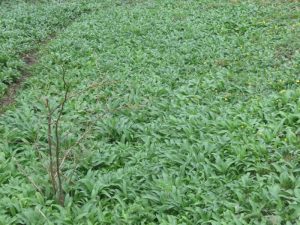Wild garlic capers
Pick emerging wild garlic flower buds now to preserve in salt brine for the months ahead.

Wild garlic capers are a great way of preserving the medicinal powers and flavours of wild garlic, for all those glorious summer barbeques and salads to come.
A spring walk in woodlands can often quickly reveal extensive carpets of the most supreme of all our wild garlics (Allium ursinum). Also known as ramsons, or bear’s garlic, our common wild garlic will be found growing in luscious dense carpets all through the spring.

This perennial plant re-appears from January onwards in milder areas, flowering from April through May. As an early season woodland plant, it will then proceed to die back when the woodland canopy has fully opened into leaf, around early June.
If you live near old woodland, especially towards the western Atlantic coast of Britain, you should soon be able to find ramsons flower buds and make a quick and tasty lacto-fermentation. In larger woodlands it is possible to pick enough in a day to make this superb health-boosting condiment last almost all year!

If you can want to read more about the medicinally valuable bulb garlic and its cousin, the wild garlic, including how to identify and tell them apart from thier look alikes, then take a look at my in-depth garlic species profile over on the Wild Plant Guide website.
You can harvest ramsons flower buds from early March carrying on through until mid April. By preserveing with lacto-fermentation, you will get to eat their powerhouse of vampire-killing medicine later on in the year, when the days are short, temperatures drop again, and various bugs and virus are doing the rounds.
To make this simple preserve, you will need:
A bag for harvesting (resealable is best for preserving freshness), a clean glass jar and lid, and the following ingredients:

A few hundred grams of ramsons flower buds.
A few grams of Sea salt.
Spring water (or dechlolrinated tap water).
What is lacto-fermentation?
This simple preserving method has been employed for thousands of years, and it’s name comes from the specific type of bacteria working their magic in the fermentation process. In this instance we are emplying the various beneficial lacto-bacillus species of bacteria, which are very similar to the ones found in milk and yoghurt.
These micro-organisms are anaerobic (perishing in air and only growing in oxygen-starved environments) and will thrive in reasonably acidic conditions.

Lacto-fermentation happens in a couple of stages….firstly by wiping out the nasty spoiling bacteria that cant survive in salty conditions, then through encouragement of the good guys, who produce lactic acid from the lactose and other sugars present in the plant material.
The benefits of fermented foods are many, including their help to the digestive system, which enables us to recover from yeast infections. They also give us a wider array of beneficial enzymes, and are supposed to have anti inflammatory activities. Oh and they taste fantastic!
When you are placing the your plant material in jars, you need to ensure a couple of things:
-
Every 100 grams of material added requires about 2-5 grams of salt. Sea salt will be great. Avoid the man-made table salt, fortified with iodine and other additives, as these are beleived to inhibit the fermentation process. The precise level of salt within the 2-5% per volume range can alter rates of fermentation; affect preservation longeivity (especially in warmer climates), alongside the obvious impacts on flavour. It not only makes it impossible for many species of nasty spoiling microbes to survive, but also creates the perfect conditions for an array of beneficial Lacto-bacillus species.
-
By packing the material in your jars as much as you can, you will be excluding the air as much as possible. You may be surprised by how much material you can push into a 500 g jar! If you bruise the material and draw some moisture out, then less water will be needed to cover the material. After absolutely packing the jar, you need to make sure the material is covered and remains covered, which can easily be done by a small stone.
The jars need burping once fermentation has got going, which is noticeable by numerous bubbles appearing in the jar, and will be accompanied by an audible release of CO2 when opening the lid. Store the ferment in a warm dark environment.
The ambient emperature determines the rate of fermentation, so during spring, the activity of the microcrobes (revealed by bubbles of carbon dioxide, and the presence of sour tasting acetic acid in the ferment), should be evident within 72 hours.
How long you want them to ferment is up to you and your preferred tastes. The longer you leave them then the more acidic the fermentation will taste. After 2-3 weeks you may want to place in a fridge if you have one, which will halt the fermentation process. Enjoy!
This wild garlic caper recipe was first published by Chris Hope on wildplantguide.com in 2017.
